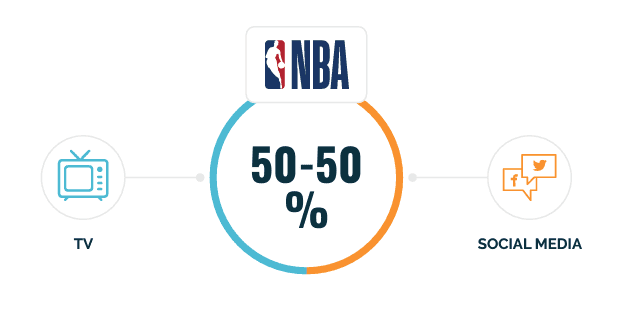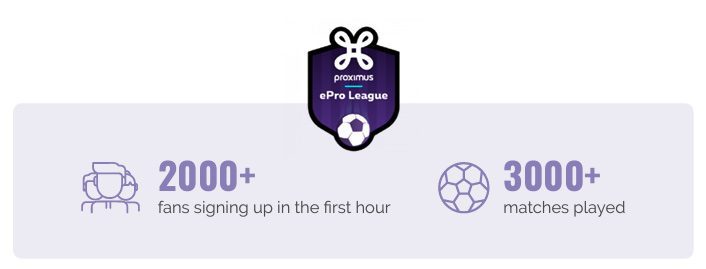Sports fans: trends and insights to engage them in a busy digital ecosystem
How to engage sports fans?
That’s the million dollar question that all sports clubs, federations, organisations and leagues are asking themselves. In this article we’ll take a look at 3 topics that are having a significant impact on the way that actors in the sports industry are facing the future.

What is going to happen when cookies disappear? What have we learned from the pandemic? And how can the sports industry adapt to the influx of new technologies to increase sports fan engagement? Keep reading to find out!
You’ll find even more of the trends and insights that are shaping the digital evolution of the sports industry in our ebook “The future is fan-tastic”. Make sure you check it out!

Whether you’re a passionate sports fan, a semi-interested bystander or have absolutely no-interest for sports whatsoever, there’s no denying that the sports industry is one of the most talked about and economically important industries in today’s society. It may be ‘just a game’, but it’s an impactful one for many businesses and organisations around the world. And one crucial component remains at the heart of the whole industry: the fans.
Football takes centre stage
With a major football competition starting in just a few days, the relevance and importance of the industry is once again at the forefront of a lot of conversations going on around the world. So let’s take a closer look at some of the trending topics that are having an impact on the sports industry!
Shiny new technology
In recent years, the galloping advancement of technology has had a significant impact on all industries, and more specifically digital technology. For the sports industry, this can be seen as both a curse and a blessing: the innovations have meant huge now opportunities, both in terms of attracting new audiences and of finding new revenue sources, but it also involves significant risks of organisations spreading themselves too thin by trying to do too much too soon.
Looking on the bright side
In a recent report, Deloitte looked at how digital transformation is changing the landscape of the sports industry, and they highlighted 4 aspects that new digital technology is having a positive impact on:
- New and innovative fan experiences: during, before and after sporting events with new digital media channels and outlets.
- Increase in fan engagement: by leveraging fan loyalty and the data fans are sharing to personalise their experiences to their individual preferences.
- Increase in the number of sponsors involved and more diversified sponsors.
- New revenue sources.
Digital fragmentation
On the opposite end of the spectrum, fragmentation is one of the challenges facing sports leagues and clubs due to this massive influx of new digital technologies. Fans are increasingly using multiple devices to interact with their favourite teams and sports, as nowadays you can stream a game while on the train or watch the highlights at any time of the day. Gone are the days where you could only watch a race or a game at a fixed time and only on television.
There is an increasingly wide range of options for watching sports and broadcasters are paying closer attention to what the fans want and expect. Take the example of BT Sports, who broadcast the 2022 Champion’s League final for free on Youtube, rather than gating it to their paying subscribers.
The younger generation is also impacting the way fans are consuming sports and the types of content they’re consuming. Social media, gamification and short content pieces are paving the way for this new way of watching a game. The NBA are expecting the 50-50% threshold between traditional broadcasting channels and social media streaming to be reached during the 2023/24 season.

Lessons learned from the pandemic

The COVID-19 pandemic had wide-ranging impacts on all aspects of our lives in 2020 and 2021, and nearly 2 years later we’re still reeling from a lot of the consequences. The sports industry was no exception and was hit hard by the pandemic, with competitions grinding to a halt, stadiums being closed and major competitions being postponed or cancelled.
In the face of such disruption, sports marketers had to react quickly and show significant flexibility and innovation to engage with fans and keep them entertained over this tough time.
So not only was the sporting impact huge, but the financial consequence was also immense, with revenue streams such as ticketing, shirt sales and broadcasting rights drying up completely. It is estimated that the Premier League being suspended cost Manchester United upwards of £20 million in 2020 and that La Liga games being cancelled cost Real Madrid in excess of €32 million in match day earnings alone.
So how did clubs and leagues survive during the pandemic, and what solutions are still having an impact on the industry 2 years later?
Clever content and meaningful relationships to engage sports fans
Clubs quickly understood the need to keep in touch with and engage with fans, to provide them with some relief and entertainment during a difficult period for everyone. They did this by providing new and different types of content on a multitude of channels, catering to audiences of all ages, locations and interests to keep fans involved.
With a lack of current content due to there being no matches, clubs had to get creative with the content they were creating and distributing during the pandemic. Some clubs turned to nostalgia and delved into their archives of footage from their glorious sporting pasts, others got their stars involved with behind-the-scenes content from their lives in lockdown or asked their fans to become reporters for the day for them with user generated content, and others turned to new forms of digital content, like TikTok videos or interactive formats.

Over 50 interactive formats to choose from for your marketing campaigns!
Esports
The rise and popularity of esports was another positive outcome from the pandemic. The new discipline, that could be carried out entirely online and from the comfort of the players’ homes, was one of the ways that clubs found the keep in touch with their fans when stadiums were closed.
And 2 years on, the industry is booming, with major European clubs and leagues having their own teams and competitions. The audience is growing at a rapid pace and it is estimated that 50% have started following since the pandemic. And the audience isn’t, as you might expect, only made up on teenage boys, the female fanbase has known the fastest growth, growing by 19% in 2021, as opposed to 12% for the male fanbase.

This large-scale and highly diverse audience means that an increasing number of sponsors are getting involved. The Cannes Lions panel reckon that global esports sponsorship will reach $1 billion in 2022, and a large number of consumer brands are joining the party, hoping to reach an audience that is different to their usual clientele, with MasterCard being the perfect example of this.
Alternative visibility for sponsors
In an ideal world, the sports industry would be fuelled by pure passion and enjoyment for sports, but we live in the real world where at the end of the day it all comes down to money. The New York Times estimates that the industry is worth $160 billion worldwide.
During the pandemic, with no games happening, clubs had the challenge of finding new ways of providing their sponsors with visibility, as they could no longer guarantee the usual match-day slots. So as with the content they were producing, they also had to get creative about providing their advertising partners with sufficient exposure.
In most cases clubs included their sponsors in the different types of content they were producing at the time, and this had an additional benefit for them both: by engaging with their fans they were also collecting valuable first-party data and zero-party data from them, such as newsletter opt-ins and preferences.

The future is cookieless – how will the sports industry cope and engage sports fans?
What have cookies got to do with sport I hear you say? Surely sport is all about passion and strategy and excitement?

Yes, yes and yes but also, sports is increasingly about data – whether it’s the sporting data that is collected from players on the pitch during training sessions or matches, or whether it’s the first-party and zero-party data that is collected from fans during their interactions with the industry.
And that’s where the link between cookies and sports occurs: fan data. When Google announced a few years ago that they wouldn’t be supporting third-party cookies on their browsers from 2024, the digital ecosphere drew a sharp shocked breath at the enormity of this decision. The last couple of years have given all parties impacted by this decision the time to consider the change and to come up with new and innovative ways of dealing with a cookieless future.
Engage sports fans? First- and zero-party data are leading the pack
The front-runners in this race to be prepared for the cookieless world, where fan preferences and information will no longer be deduced or bought via third-party cookies, look to be first-party and zero-party data.
By collecting these types of data from their fans, sports leagues and teams can engage with them on a more meaningful level, as they’re building a relationship that is built on trust and there is a value exchange. Not only are they getting to know their fans more, by learning valuable information that will enable to them to understand their preferences and expectations, they’re also improving the experiences they provide to their fans by taking their feedback into account.
Make sure you read our “The future is fan-tastic” ebook to find out more about the implications and consequences of the cookieless world on the relationship between sports clubs and their fans!
It ain’t over ’til the fat lady sings!
So before the final whistle goes, what lessons have we learned from the pandemic, the upcoming cookieless world and the amount of new technology available to the sports industry?
More than ever, it’s all about the fans!
For any club, team, league, organisation, federation in the sports industry who wants to survive and thrive in the current busy and all-encompassing digital world, the fan needs to be placed firmly at the heart of everything they do. All of their data collection strategy and marketing plans need to revolve around the fans.

They need to be listening to, interacting with and engaging with their fans – to get to know them better, to understand their needs and expectations and to improve the experience they’re providing them with.
Read our ebook all about the sports industry “The future is fan-tastic“ to find out how major European clubs and teams are using first-party and zero-party data collection and interactive marketing to build meaningful relationships with their fans.
Discover more about Qualifio’s all-in-one fan engagement solution!








